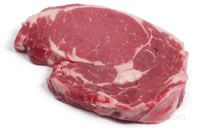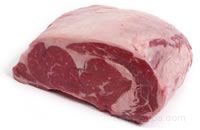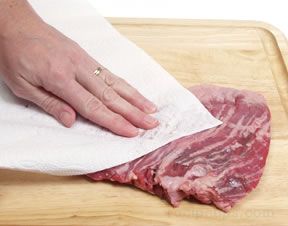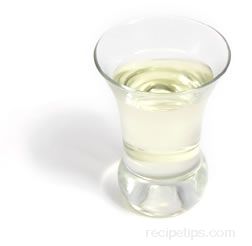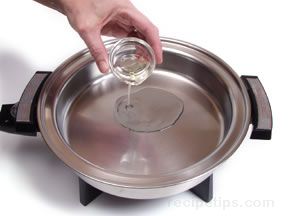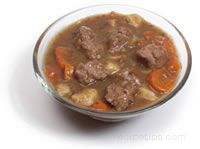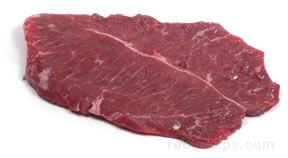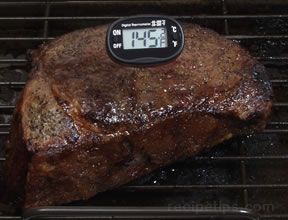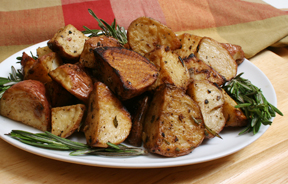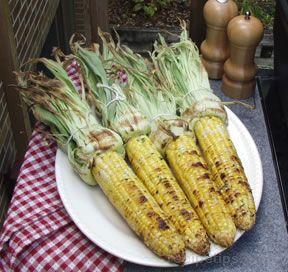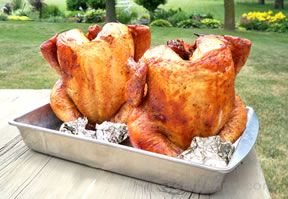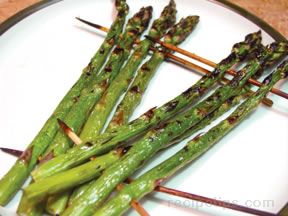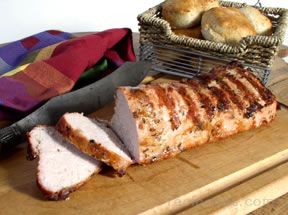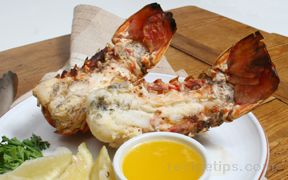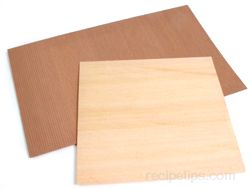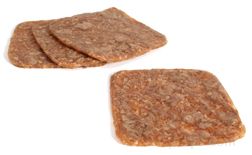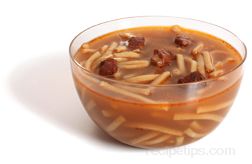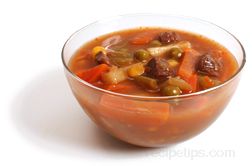|
Types of Grills
| |||||||||||||||||||||||||||||||||||||||||||||||||||||||||||||||||||||||||||||||||||||||||||||||||||||
|
Setting up an outdoor grill is an easy process, but care must be taken to ensure safety. The following safety points should always be considered when grilling outdoors:
|
|
The amount of charcoal required depends on how much of the area of the grate will be used for cooking. If the entire area of the grate will be used for cooking, an even layer of coals should be spread across the entire bottom of the grill. If only a portion of the grate will be used for cooking, the coals should extend about 2 inches beyond the area where the food will be cooked. |
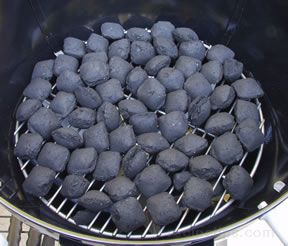 |
| After determining the correct quantity of charcoal to use, the briquettes can be placed in a mound in the center of the grill. | 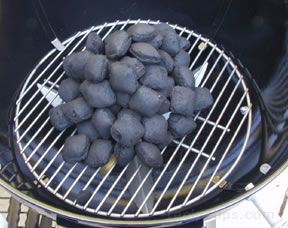 |
|
Self-lighting briquettes, containing a petroleum product for easy lighting, can be used. The coals are easily lit with a long match. An alternative, for those who do not like using petroleum products, is to use regular briquettes, which can be lit more easily with the aid of a chimney starter. Newspaper is placed in the bottom of the chimney and the charcoal is placed on top. The newspaper is lit from the bottom and the fire is drawn up to the charcoal above. |
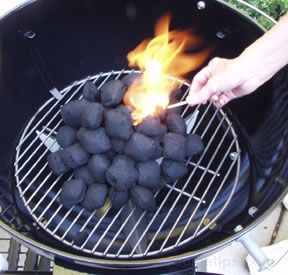 |
|
The charcoals are ready when they are glowing and are evenly coated with a layer of gray ash. This process usually requires at least 30 minutes. The coals can then be spread evenly across the bottom for direct heat grilling or they can be placed in several different configurations for indirect heat grilling. |
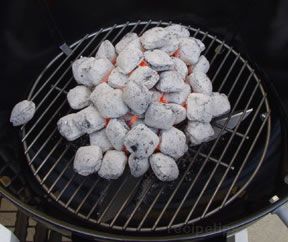 |
| Many people like to add a small log or two of their favorite hardwood, such as apple or oak, to the coals in order to provide a more pronounced smoked flavor to the food. Softwoods should not be used because they burn too quickly, do not provide good flavor, and emit too much soot. | |
|
An easy method for estimating the grilling temperature is to place the palm of your hand 3 or 4 inches above the grate. The length of time you can leave your hand comfortably above the grate determines the heat intensity:
|
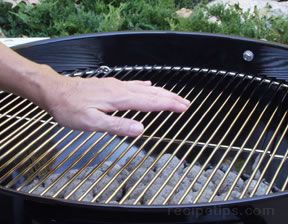 |
|
Use a long handled brush to oil the grate before grilling any food. This will help prevent food from sticking to the grate. |
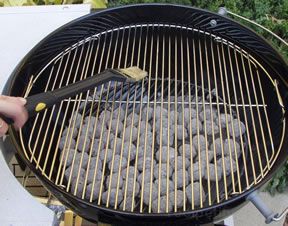 |
| A charcoal grill can be used for about an hour before the coals begin to die out and the heat is no longer sufficient to continue cooking. If a longer cooking time is required, the coals must be replenished. It is best to remove the grate, add the coals, and wait until they are properly lit before continuing with the cooking process. The fresh charcoal usually requires only half the length of time (about 15 minutes) to be ready than starting coals from scratch. | |
| Note: It is very important to open the hood of the gas grill before attempting to ignite the burners. It can be dangerous to start the burners with the hood down because gas can build up under the closed hood and may cause an explosion. Always follow the manufacturers instructions. |
| To confirm that the burner has lit, hold your hand over the grate in order to feel the heat rising from the burner. |  |
| Once the main burner is lit, the other burners light automatically by simply turning on their respective control knobs to start the flow of gas. All the burners should be turned to "high" in order to properly preheat the grill. | 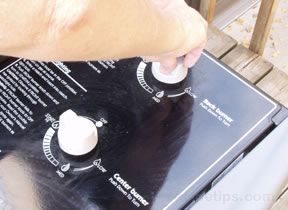 |
| The hood should be closed while the grill preheats. Some gas grills are equipped with thermometers built into the hoods (as shown on the right front of the hood of the grill that is pictured), which provide a reasonably accurate temperature reading when the hood is closed. | 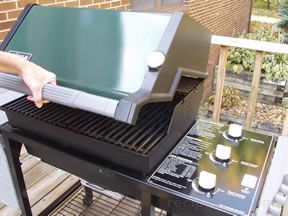 |
| Use a long handled brush to oil the grate before grilling any food. This will help prevent food from sticking to the grate. |  |
Preparation of Beef Cuts
| Some beef cuts may require some preliminary preparation, such as boning, trimming, tying, or tenderizing, before they are grilled. |
| Boning or extra trimming may be required for some beef cuts, which can be done while the grill preheats. The outer fat layer can be trimmed down to 1/8" to reduce the amount of fat. It is important to leave at least 1/8" of fat to help seal in the juices while the meat is cooking. | 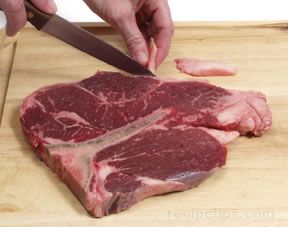 |
| When grilling steaks, better results are produced when the fat is slashed at 1-inch intervals around the perimeter of the steak. This helps to reduce the tendency of the steak to curl up during the grilling process. | 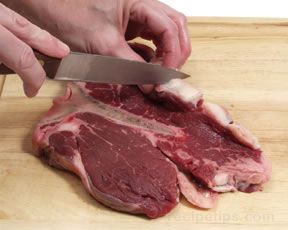 |
| Some beef roasts may require tying to maintain the shape during the grilling process and to allow the roast to cook as evenly as possible. Beef cuts that have been boned are often rolled and tied to create a uniform shape, which makes slicing much easier after the meat is grilled. | 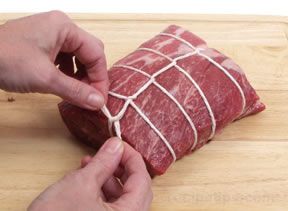 |
| Some beef cuts may require tenderizing, either by pounding, marinating, applying a rub, or barding. Beef can be tenderized while waiting for the grill to preheat, although when marinating beef, it may be best to allow additional time for the meat to soak in the marinade. |  |
Direct Heat Grilling
|
Cooking with direct heat is accomplished by placing cuts of beef on a grate directly over the heat source. For outdoor grilling, the grate can be positioned over an open fire or wood burning grilling unit, a charcoal grill, or a gas grill. |
| Direct Heat Grilling on Charcoal Grills | |
|
When beef is cooked with direct heat on a charcoal grill, the coals are usually spread in an even layer on the bottom of the grill. This provides a consistently hot, even temperature under the entire cooking surface. |
 |
| The cooking temperature typically reaches 450ºF to 650ºF when grilling over direct heat. Thin cuts of meat are quickly grilled over such high temperatures and should only be turned once to cook both sides. | 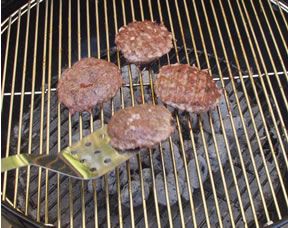 |
| Direct Heat Grilling on Gas Grills | |
| When grilling beef with direct heat on a gas grill, all of the burners are lit to provide a uniform temperature under the entire cooking surface (grate). |  |
| The meat is cooked quickly over burners set to medium to high heat. Thin steaks, under ¾ inch thick, should be cooked over high heat for only 2 or 3 minutes per side and watched carefully to prevent overcooking. Thin cuts of beef are usually turned only once during the cooking process and are cooked with the hood down. |  |
| When grilling steaks, use tongs or a spatula to turn the meat. A fork should not be used because it pierces the meat allowing juices to escape. Hamburger patties should be turned with a spatula. | 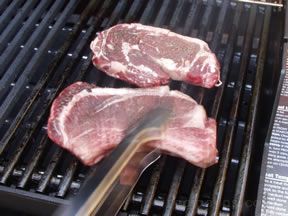 |
|
| |
Indirect Heat Grilling
|
The purpose of indirect heat cooking on a grill is to allow thicker cuts of beef to cook thoroughly while preventing the surface of the meat from burning. Indirect heat cooking is often done in conjunction with direct heat cooking. Large beef cuts are usually seared over direct heat and then the cooking process is finished using indirect heat to slowly cook the meat to the desired doneness. |
|
Indirect Heat Grilling on Charcoal Grills Once the preliminary steps are finished (grill setup, meat preparation, etc.), there are several easy steps to follow in order to cook beef with indirect heat on a charcoal grill. | |
| The coals can be pushed to one side of the grill and a pan is placed on the opposite side. The pan is used to catch fat as it melts and drips from the meat as it cooks, reducing flare-ups. | 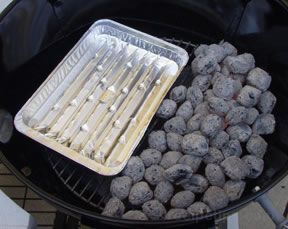 |
| Before actually cooking a thick cut of beef with indirect heat, such as the small chuck eye roast shown on the right, the meat is usually seared on all sides, using direct heat, in order to create a flavorful crust on the surface. The meat is seared directly over the coals that have been placed on one side of the grill. Use a tongs or spatula to turn the meat. Do not use any utensil that will pierce the meat, allowing juices to escape. |  |
| After the searing process is complete, the beef is placed on the opposite side of the grill, away from the coals and over the drip pan. The grill is covered and the beef is cooked to the appropriate doneness. |  |
| An alternative method for arranging coals for indirect heat grilling is to place half the coals on one side of the grill and the other half on the opposite side. Some charcoal grills are equipped with side baskets, which can be used for this purpose. A drip pan is placed between the coals under the location where the meat will be cooked. | 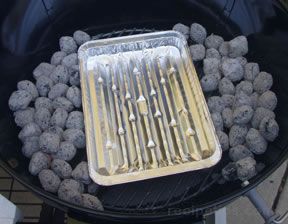 |
| A third method of arranging the coals is to bank them into a ring around the outer edges. Again, a drip pan is used under the meat. The grill should be covered while the beef cooks (which is true for any of the three methods of arranging coals). |  |
| Indirect Heat Grilling on Gas Grills | |
| A thick cut of beef, such as the boneless sirloin roast shown on the right, is seared on all sides over direct heat before it is cooked to the proper doneness using indirect heat. A tongs and/or spatula should be used to turn the roast. Using a meat fork will pierce the meat allowing juices to escape. | 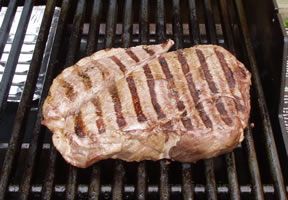 |
| All of the burners, except one, are turned off. For the grill pictured at right, the center and rear burners are turned off and the front burner remains lit (on high heat). | 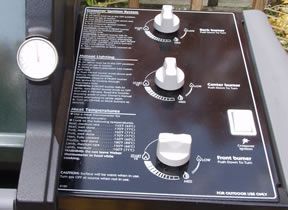 |
| A drip pan is placed on the opposite side away from the direct heat of the front gas burner and under the location where the meat will be cooked. | 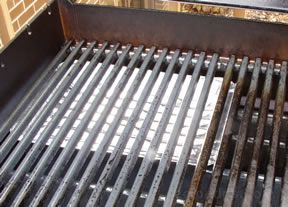 |
| The seared beef roast is placed on the area of the grate over the drip pan, away from the direct heat of the front burner. | 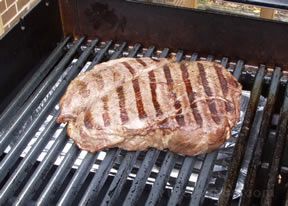 |
| The heat from the one burner is sufficient to cook the meat, indirectly, especially when the hood is closed to hold the heat within the grill. |  |
| Larger cuts of beef, such as roasts and ribs, benefit from cooking with indirect heat because the meat remains juicy and tender and the risk of overcooking the meat is reduced. | 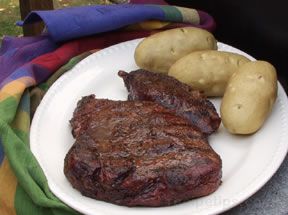 |
Doneness of Steaks
|
Some people like their steak cooked to no more than rare (125ºF to 130ºF, using traditional guidelines), but this is not recommended. The internal temperature of the meat is not sufficient to kill harmful bacteria that may be present. |






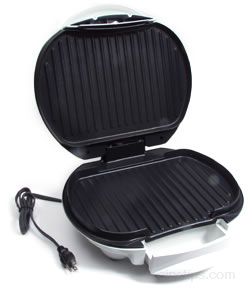

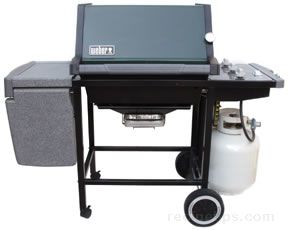
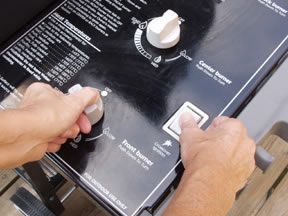
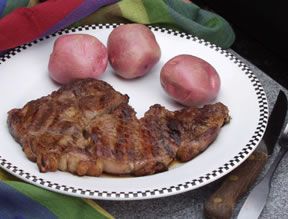 Beefsteaks are among the most popular cuts of meat that are cooked on an outdoor grill. Most people select tender cuts such as the Porterhouse, T-bone, rib-eye, or tenderloin steaks, but there are other
Beefsteaks are among the most popular cuts of meat that are cooked on an outdoor grill. Most people select tender cuts such as the Porterhouse, T-bone, rib-eye, or tenderloin steaks, but there are other  Grilled beefsteaks are safe to eat if the center is still a bit pink. Harmful bacteria are killed if the internal temperature reaches 145ºF (
Grilled beefsteaks are safe to eat if the center is still a bit pink. Harmful bacteria are killed if the internal temperature reaches 145ºF (
